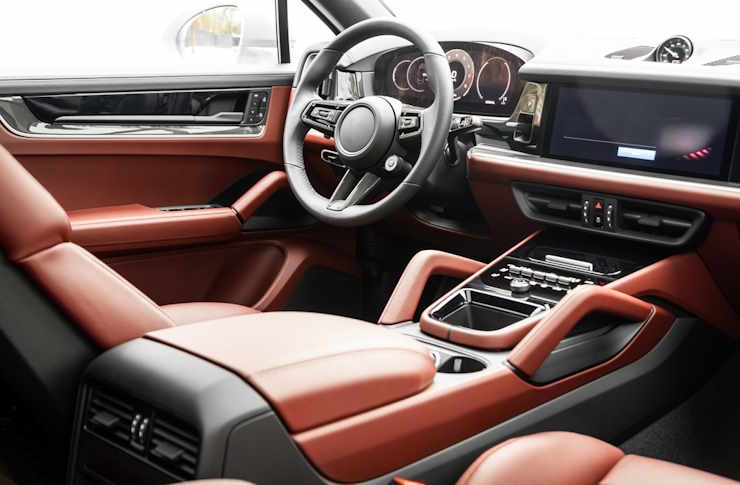What You Should Know About the 2025 Toyota Kluger: Hybrid Innovation Meets Mid-Size Luxury
The 2025 Toyota Kluger represents a significant step forward in the hybrid mid-size SUV segment, combining advanced powertrain technology with spacious seven-seat versatility. As families and eco-conscious drivers seek vehicles that balance performance, efficiency, and comfort, the latest Kluger model addresses these needs with refined engineering and thoughtful design updates. Understanding what this vehicle offers can help potential buyers make informed decisions in an increasingly competitive market.

The automotive landscape continues to evolve, and Toyota’s commitment to hybrid technology remains at the forefront of this transformation. The 2025 Kluger arrives with enhancements that build upon its established reputation while introducing innovations that reflect current driver expectations. For those considering a family-friendly SUV with hybrid credentials, this model warrants close examination.
How the 2025 Kluger Hybrid Uses Toyota’s Latest Powertrain
The 2025 Kluger employs Toyota’s refined hybrid system, pairing a 2.5-liter four-cylinder engine with electric motors to deliver smooth, responsive performance across seven seats. This configuration typically produces combined outputs in the range of 180 to 240 horsepower, depending on the specific variant and market. The system intelligently distributes power between the combustion engine and electric motors, optimizing fuel consumption during city driving while maintaining highway capability.
The hybrid architecture incorporates continuously variable transmission technology, which eliminates traditional gear shifts for seamless acceleration. Regenerative braking captures energy that would otherwise be lost, recharging the battery pack during deceleration. This approach contributes to fuel economy figures that often exceed conventional gasoline-only competitors by 20 to 30 percent, though actual results vary based on driving conditions and habits.
All-wheel drive capability in hybrid variants typically operates through an additional rear electric motor, providing traction without the weight and complexity of mechanical driveshafts. This setup enhances stability in varied weather conditions while maintaining the efficiency advantages that make hybrid powertrains attractive to cost-conscious families.
What the Updated Design and Interior Features Bring
Exterior updates for 2025 include revised front fascia elements, updated lighting signatures, and refined body contours that enhance aerodynamic efficiency. These changes contribute to both visual appeal and practical benefits, as improved airflow reduces drag and supports fuel economy targets. The design maintains the Kluger’s recognizable silhouette while incorporating contemporary styling cues that align with Toyota’s current design language.
Inside, the cabin receives attention to materials, technology integration, and spatial efficiency. The dashboard typically features a central touchscreen ranging from 8 to 12.3 inches, depending on trim level, providing access to navigation, entertainment, and vehicle settings. Wireless smartphone connectivity has become standard or widely available, reducing cable clutter and streamlining device integration.
Seating configurations prioritize flexibility, with second-row options that may include captain’s chairs or a bench arrangement. Third-row access improves through thoughtful engineering of seat folding mechanisms, making it easier for passengers to reach rear positions. Cargo capacity remains competitive within the segment, offering approximately 550 to 1,150 liters with seats in use, expanding significantly when rear rows fold flat.
Climate control systems often feature multi-zone capability, allowing different cabin areas to maintain individual temperature preferences. Sound insulation improvements reduce road and wind noise, contributing to a more refined driving experience during longer journeys. These enhancements collectively elevate the Kluger’s appeal as a daily driver and family transport solution.
Why the Kluger Remains a Compelling Choice for Buyers
The combination of hybrid efficiency, seven-seat practicality, and Toyota’s reliability reputation positions the 2025 Kluger as a noteworthy option for specific buyer profiles. Families requiring three rows of seating without the size and fuel consumption of larger SUVs find value in this mid-size platform. The hybrid powertrain addresses concerns about operating costs, particularly for drivers covering moderate to high annual mileage.
Safety features typically include Toyota Safety Sense technology, encompassing adaptive cruise control, lane departure warning, automatic emergency braking, and blind-spot monitoring. These systems contribute to confidence during daily commutes and highway travel, addressing practical safety considerations that matter to families.
Warranty coverage for hybrid components often extends beyond standard vehicle warranties, with battery packs frequently covered for eight to ten years or 160,000 kilometers, depending on regional regulations. This extended protection addresses common concerns about hybrid system longevity and potential replacement costs.
Resale value considerations favor Toyota products generally, and hybrid variants often maintain stronger residual values compared to conventional alternatives. This factor influences total cost of ownership calculations, potentially offsetting higher initial purchase prices through better returns when upgrading or selling.
Understanding Ownership Costs and Value Considerations
While specific pricing varies by market, trim level, and optional features, the 2025 Kluger typically positions itself in the mid-range of the hybrid SUV segment. Entry-level variants may start around 50,000 to 55,000 USD or equivalent, with fully equipped models reaching 65,000 to 70,000 USD. These figures represent general market positioning and should be verified with local dealers, as regional variations, taxes, and incentives significantly affect final costs.
Fuel efficiency advantages translate to measurable savings over ownership periods. Assuming average fuel prices and typical annual mileage, hybrid variants may save 800 to 1,500 USD annually compared to non-hybrid competitors, though individual results depend on driving patterns and local fuel costs. Maintenance requirements for hybrid systems generally align with conventional vehicles, though brake wear often reduces due to regenerative braking systems.
Insurance costs, registration fees, and potential hybrid incentives vary by location. Some regions offer tax credits, reduced registration fees, or access to carpool lanes for hybrid vehicles, adding value beyond fuel savings. Prospective buyers should research local regulations and available incentives when calculating total ownership costs.
Prices, rates, or cost estimates mentioned in this article are based on the latest available information but may change over time. Independent research is advised before making financial decisions.
Technology and Connectivity Features
Modern connectivity expectations receive attention in the 2025 Kluger through integration of smartphone platforms, voice recognition systems, and available premium audio options. Wireless charging pads accommodate compatible devices, while multiple USB ports throughout the cabin ensure all passengers can maintain device power during travel.
Available digital instrument clusters replace traditional gauges, providing customizable displays that show navigation, efficiency metrics, and vehicle information. Head-up display technology, when equipped, projects key data onto the windshield, allowing drivers to monitor speed and navigation without looking away from the road.
Over-the-air update capability, where available, allows certain vehicle systems to receive software improvements without requiring dealer visits. This feature ensures that infotainment and some vehicle systems remain current throughout ownership, addressing a common concern with automotive technology obsolescence.
Practical Considerations for Potential Buyers
Test driving remains essential for evaluating whether the Kluger’s driving dynamics, seating comfort, and visibility meet individual preferences. Hybrid powertrains deliver different acceleration characteristics compared to conventional engines, and experiencing this firsthand helps set appropriate expectations.
Comparing the Kluger against competitors such as the Honda Pilot Hybrid, Mazda CX-90, and Hyundai Palisade provides context for feature sets, pricing, and performance characteristics. Each alternative offers distinct advantages, and thorough comparison shopping ensures buyers select the vehicle that best matches their priorities.
Considering long-term needs helps avoid premature vehicle changes. Families anticipating growth or changing transportation requirements should evaluate whether seven-seat capacity, cargo space, and towing capability align with projected future needs, not just current circumstances.
The 2025 Toyota Kluger delivers on its promise of hybrid efficiency within a practical, family-oriented package. Its combination of proven technology, thoughtful updates, and Toyota’s established reputation creates a compelling proposition for buyers seeking mid-size SUV capability with reduced environmental impact and operating costs. As with any significant purchase, thorough research, comparison shopping, and careful evaluation of personal needs remain essential steps toward making the right choice.




